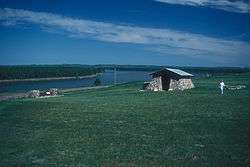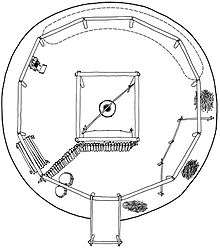Double Ditch
Double Ditch, also known as the Double Ditch State Historic Site, Burgois Site, 32BL8, Bourgois Site, and Double Ditch Earth Lodge Village Site, is an archaeological site located on the east bank of the Missouri River[2] north of Bismarck, North Dakota, United States. It is named for the two visible trenches that once served as fortifications for the village, but archaeologists found a further two ditches outside these indicating that the population was originally larger.[3]

Double Ditch State Historic Site | |
 | |
  | |
| Nearest city | Bismarck, North Dakota |
|---|---|
| Area | 37.5 acres (15.2 ha) |
| NRHP reference No. | 79001769, 14000896[1] |
| Added to NRHP | January 29, 1979 |
The site was the location of a Mandan Native American earth lodge village from approximately 1450A.D.[2] to 1785 A.D. It was abandoned after the 1775–1782 North American smallpox epidemic.[4] The site includes remains of earth lodges, midden mounds, and fortification ditches. It is managed by the State Historical Society of North Dakota.
The site is the subject of two listings on National Register of Historic Places: one for its archaeological significance in 1979, the other for its Depression-era park structures in 2014.[1]
Overview


The Mandans built dome-shaped houses of logs and earth, known as earth-lodges.[5] The raised areas around the village are midden mounds or earthen mounds ranging from one to ten feet high. There are more than 30 mounds surrounding the village. Fortification systems consisted of a deep moat and a wall of wooden posts that formed a palisade. Natural features, such as steep terrain and riverbanks, also were used for added protection.[5]
Population decline
In 2002 Kenneth Kvamme generated digitally enhanced maps of Double Ditch using radio gradiometry techniques. The new survey methods revealed two more ditches, outside the two that were already known, extending the village well beyond its known boundaries. Investigators concluded that at the time of its founding, just before 1500, Double Ditch had a peak population of two thousand and an area of 19 acres.[3] In the mid-to late 1500s, a new trench—ditch 3— was built inside ditch 4. This was also soon abandoned and ditch 2, the outermost of the two ditches still visible constructed inside ditch 3. There was a 20 percent reduction in the area of the town by 1600. The loss of population may have been due to drought or infection. [2] In the mid 18th Century, the innermost (and still visible) fortification ditch was constructed, enclosing an area of four acres, indicating a population at that time of fewer than four hundred[2]. At that time, the entire surface layer of dirt in the village was laboriously scraped off, possibly after a horrific infection.[2]
See also
- Chief Looking's Village site (32BL3), also a Heart River Mandan village site, also NRHP-listed
References
- "National Register Information System". National Register of Historic Places. National Park Service. July 9, 2010.
- Elizabeth Fenn: Encounters at the Heart of the World: a History of the Mandan People
- Kvamme, Kenneth L. "Archaeological prospecting at the Double Ditch State Historic Site, North Dakota, USA". Archaeological Prospection. 15: 62–79. doi:10.1002/arp.325.
- "Double Ditch Indian Village". State Historical Society of North Dakota. Retrieved August 7, 2012.
- "Double Ditch Indian Village - History - State Historical Society of North Dakota". history.nd.gov. Retrieved 2016-01-08.